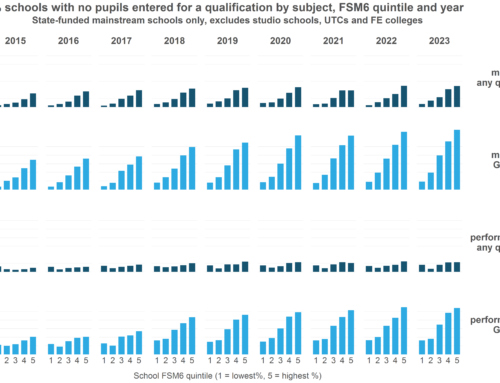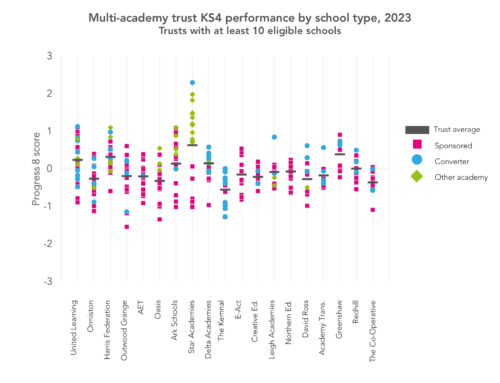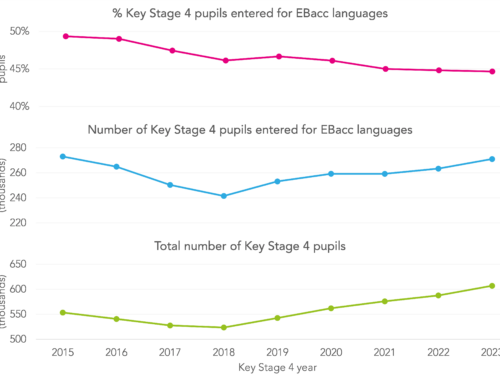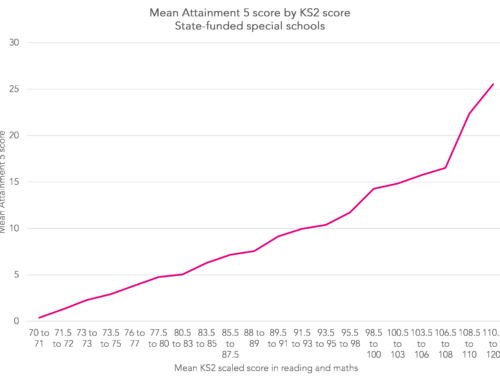
Three school censuses are carried out each year – in October, January and May – recording which pupils are on-roll at which schools.
When it comes to inclusion in a mainstream secondary school’s league table results, everything hinges on the census carried out in the January of a child’s Year 11 year.
Broadly speaking, if a child is recorded as being on roll at a particular school, they count in that school’s results, and if they’re not, they don’t.
There are exceptions. If a pupil arrived in the country in the last two years and comes from a country where English is not the official language they can be omitted from results.
Likewise if a pupil has been permanently excluded from one school in the last two years, another school that accepts them does not have to count that child’s results in their overall results – intended to mean schools aren’t disincentivised from accepting pupils who have been excluded.
If a child is permanently excluded but does not join the roll of another education institution, the excluding school can also ask for that pupil’s results to be attributed to them.
Schools are also allowed to request amendments, in the small number of cases where a pupil has left England permanently, or died.
There are also something called penalty add-backs, which affects how the results of pupils reaching age 16 before Year 11 are accounted for. These pupils are always reported in a school’s results the year after which they have been in Year 10, meaning there is no possibility of them repeatedly being counted as not having reached the end of secondary school.
But, fundamentally it’s a case of: if a child was recorded as having been on-roll at a mainstream secondary school on 15 January 2015, they would have counted in that school’s results in summer 2015.
Our reweighting approach
Under our reweighting approach, following a methodology developed for a report we published at the end of 2015 [PDF], school league tables are reweighted to take account of every pupil who had spent time at a school, in proportion to the amount of time they spent there.
For most secondary schools, which admit in Year 7, a pupil can have spent a maximum of 15 terms there – three terms in each of five years – before reaching the end of secondary school.
So we allocate pupils’ results to the institutions which they have spent time on-roll at as part of their secondary education in proportion to the amount of time they spent on-roll there – 100% if they spent all fifteen terms there; 40% if they spent only six terms there, say.
Crucially, then, where a pupil is recorded as being on-roll in January of their Year 11 year does not have the great importance that it does under league tables as they stand now.
That means that the minority of schools that might be inclined to try and game the league tables by losing pupils before this date wouldn’t have such a strong incentive to do so – as the pupil’s results would still contribute to how they themselves were judged.
In our work we looked at four cohorts of pupils: those finishing secondary school in 2011/12, 2012/13, 2013/14 and 2014/15
Our population of around 2,900 schools was produced by applying the following criteria:
- all mainstream, state-funded secondaries that admit children in Year 7 were taken as a starting point;
- schools where a large number of pupils – two classes-worth – joined after Year 7 were excluded;
- the school had to have been open for the entire five-year period ending with the year under consideration (taking into account any predecessor school that exists);
- the school had at least 11 pupils recorded as completing KS4 and counting towards league table results for that school for the relevant academic year.
Where a school changed status – becoming an academy part way through the period being looked at – records were linked together and the school treated as one entity.
Under our approach, we are adding back in pupils who may legitimately have left the English education system – leaving the country permanently, or in some cases dying – and are counting these pupils as if they did not achieve five good GCSEs or equivalents. But we think these are very much a minority of cases, with the majority of children who disappear from schools rolls and don’t show as having achieved any qualifications having entered informal private or home-schooling arrangements and not taken any qualifications there. It’s also worth remembering that under our reweighting approach, these pupils only count to the extent that they spent time on a school’s roll – so if they only spent a year there they would count relatively little.
And if the Department for Education were to adopt our suggestion of reweighting league tables, it wouldn’t be too difficult to filter out these small number of cases, using established processes.
Now read the rest of Datalab’s ‘Who’s left’ series of posts.






So does this mean that if we accept a pupil from another school in Year 11 they won’t count in our statistics?
Hi Bev. It’s the January census of Year 11 that plays an important role in determining where a child counts in performance tables – though, as noted, there are a number of other rules that interact with this one.
If a pupil was enrolled as a ‘Subsidiary – Main registration’, will this still count towards the school’s performance tables?
Hi Andrew. If a pupil has main and subsidiary registrations at, say, a mainstream school and a PRU, they would count for performance tables purposes against the establishment where they have the main registration – the mainstream school in most cases; the PRU less commonly.
Hi, you say that “if a pupil has been permanently excluded from one school in the last two years, another school that accepts them does not have to count that child’s results in their overall results …”. Do you know whether the results of such a student would automatically be removed from our data (the accepting school) by the DfE, or would we have to request this removal via the data checking exercise in September? Thanks.
I would like to know the above information regarding excluded pupils
Thank you
Hi Kate, is there something specific about excluded pupils that you’d like to know that isn’t covered in the above post? Best, Philip
Regarding the 2 year rule for foreign students, do you have a list of the countries which have English as an official language, please?
Hi Shirley. In previous years, a document with this information has been published on the September secondary checking exercise website. I can’t see a 2018 document yet, but I imagine that’s where it will be published when it is available.
A child in year 11 had been permanently excluded but the decision was quashed by an IRP due to illegalities however the Board of Governors decided to not overturn the decision of the headteacher to permanently exclude the child which then resulted in a fine.
The child was sent to a non mainstream school which is specifically for children who have all different needs and was offered 16 hours per week of education.
The GCSE results arrived on the mainstream headed paper. Does this mean the child is on the roll of the mainstream school or is it possible for a child to be on the roll of the alternative school but results are still against the mainstream school? I was not sure if this was a way to avoid paying the fine?
Hello Amanda. This sounds rather curious, but is probably going to the limits of how possible it is to fully understand individual cases. If the child had joined the roll of the second school then, no, the child’s results should not have counted for the mainstream school. Where a pupil is permanently excluded, the excluding school is able to ask for the pupil’s results to be attributed to them only in cases where the pupil does not join the roll of another school. I’m slightly unclear, though, how this works if the place a child moves to is an establishment that is not registered as a school – which can be the case where the establishment does not provide full-time education. As far as I can see, the DfE’s guidance isn’t explicit about what happens in cases like that, so I’m not sure what happens in practice, I’m afraid.
If a child is removed from a schools roll by a parent wishing to home educate, does the pupil’s results count for the school and if not, where are they attributed? If not, does this also follow the same timeline (i.e. January census of year 11)?
Hi Phill, the rules apply to pupils removed for elective home education in the same way – if the pupil leaves the school roll before the January of Year 11 they won’t count toward’s the school’s results, and won’t count anywhere in the school league tables.
Am I right in saying that if a student is home educated or at alternative provision before the census but fails to take a formal examination they then will count against the school in the performance tables?
Hi Matt – not really. In the situation you describe, if the pupil has left the roll of the school before the January census then they won’t count in the school’s results.
Hi Philip,
We have a pupil who is re-sitting Year 11 with us having already completed Year 11 at a different school but not done very well. He has already counted in their league tables – will he count in ours again at the end of the year?
Thanks
Hi Jo, I’m afraid I don’t know the answer to that question. I’d have to direct you to the DfE in this instance.
Best,
Philip
How do the rules apply to KS5 students? If they leave during the course, where does that leave the school?
Hi Richard. It’s complicated is the short answer, and depends which measures you’re looking at. In general, pupils who leave will be included as non-completors in retention measures but only included in attainment measures if they took any qualifications at your school in the last three years. The full DfE guidance can be found at https://assets.publishing.service.gov.uk/government/uploads/system/uploads/attachment_data/file/819734/16-18_Accountability_Measures_Technical_Guide_July_2019.pdf
Hi
If a student is permanently excluded in Y11 in December and is admitted to a Pru as dual registered, then admitted as single registered and taken off our roll after Jan census (once the hearing has taken place), does this students results will count in our head line figures?
Hi Kirsty. You’ll be able to ask for them to be removed from your results in the June checking exercise.
Hi
We are a secondary school and have been asked by another school if we could take one of their students and register them as Subsidiary – Dual Registration and the other school would remain as the Main School.
My question is, would the students GCSE results count in our exams results or the other schools?
Hi Colleen, I believe the pupil would count in the results of the main school. The guidance that the DfE publishes on the September secondary checking exercise should give you the definitive answer on this.
Hello,
We had a pupil who was off rolled at the end of Year 10. The pupil then went to a school abroad (in Africa), and was not included in our Autumn or January Census. We think the pupil is about to join our roll again (post Jan Census) but my concern is that they will still count towards our performance tables as they were last on our school roll when they were in Year 10.
Do you know whether they will count towards our performance tables?
Thanks!
Hi Stephanie, I’d have to refer you to the DfE for them to answer your query.
Hi Phillip,
Thanks for your article- it’s very informative.
You mentioned that if a child arrives to the UK from a country where the main language is not English, then they may be omitted from performance results. Is this the case just for England, or does this apply to all devolved nations?
Thanks so much,
Amy
Hi,
we have a child who is due to start with us in Y7 next academic year, who has been held back (summer born, parental decision to delay entry into education)
I am trying to get clarification on when they count in your GCSE results.
Would they
A. count in the year they turn 16 and should be in Y11, therefore will be negative on P8 as they have not sat exams
B. count in the year they turn 17, when they would sit GCSEs and be in Y11
Thanks
Natalie
Hi Natalie. It would be B. KS4 Performance Tables are based on pupils on roll in Year 11 in the January School Census.
If I remove a student from exam entries before the January census will those subjects will count in P8 ?
Hi Anna. If the student is in Y11 in your January School Census return they will count in P8.
We have a Y11 student who left our roll for home education in September 2023. It has now transpired that the home education was not satisfactory and we are to readmit this student. They were not in our January census, will they be included in our headline figures with the DfE?
Hi Gill. I must admit that’s a set of circumstances I’ve not come across before so I wouldn’t be confident in answering.